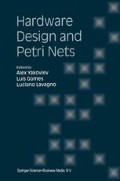Abstract
Memory subsystems often turn out to be the main performance bottleneck in current computer systems. Nevertheless, the architectural features of common RAM chips are not utilized to their limits. Therefore, a complex Petri Net model of a memory subsystem was developed and investigated to explore possible improvements. This chapter reports the results of a case study in which widely used synchronous RAMs were examined. It demonstrates how impressive throughput increases can be obtained by an enhanced memory controller scheme that could even make second level caches redundant in cost or power dissipation critical systems.
Furthermore, using colored time Petri nets leads to a descriptive view of the memory subsystem because a Petri Net model combines data and control flow as well as structural information in a natural way. The case study finally underpins the advantages of this approach.
Access this chapter
Tax calculation will be finalised at checkout
Purchases are for personal use only
Preview
Unable to display preview. Download preview PDF.
References
Advanced Micro Devices Inc. AMD-640 System Controller,June 1997.
Keith Boland and Apostolos Dollas. Predicting and precluding problems with memory latency. IEEE Micro, 14(4):59–67, August 1994.
Grady Booch. Object-oriented analysis and design, with applications. Benjamin/Cummings, 2nd edition, 1994.
Frank P. Burns, Albert M. Koelmans, and Alex V. Yakovlev. Analysing superscalar processor architectures with coloured Petri nets. International Journal on Software Tools for Technology Transfer, Springer-Verlag, 2(2):182–191, 1998.
Bob Cmelik and David Keppel. Shade: A fast instruction-set simulator for execution profiling. Proceedings of the 1994 ACM SIGMETRICS Conference on the Measurement and Modeling of Computer Systems,pages 128–137, May 1994.
Computer Engineering and Networks Laboratory (TIK), Swiss Federal Institute of Technology (ETH) Zurich, Switzerland, http://www. tik. ee . ethz. ch/ “codesign. CodeSign project.
Richard Crisp. Direct Rambus technology: The new main memory standard. IEEE Micro, 17 (6): 18–28, November 1997.
Robert Esser. An Object Oriented Petri Net Approach to Embedded System Design. PhD thesis, Computer Engineering and Networks Laboratory (TIK), ETH Zurich, Switzerland, 1996.
David Harel. Statecharts: A visual formalism for complex systems. Science of Computer Programming, 8 (3): 231–274, 1987.
IBM Corp. 64Mb Synchronous DRAM - Die Revision A, IBM0364164 C March 1998.
Intel Corp. 430TX PCISET: 82439TX System Controller (MTXC) Specification & Specification Update March 1998.
Kurt Jensen. Coloured Petri Nets: Basic Concepts, Analysis Methods and Practical Use,volume 1: Basic Concepts of EATCS Monographs in Computer Science. Springer-Verlag, 1992.
Yasunao Katayama. Trends in semiconductor memories. IEEE Micro, 17 (6): 10–17, November 1997.
Tadao Murata. Petri nets: Properties, analysis, and applications. Proceedings of the IEEE, 77 (4): 541–580, April 1989.
Betty Prince. High Performance Memories. John Wiley & Sons Ltd., 1996.
James Rumbaugh, Michael Blaha, William Premerlani, and Frederick Eddy. Object-oriented modeling and design. Prentice Hall, Englewood Cliffs, New Jersey, USA, 1991.
Bran Selic, Garth Gullekson, and Paul Ward. Real-time object-oriented modeling. John Wiley & Sons Ltd., 1994.
Silicon Integrated Systems Corp. SiS5591/5592 Pentium PCI A.G.PChipset January 1998.
Author information
Authors and Affiliations
Editor information
Editors and Affiliations
Rights and permissions
Copyright information
© 2000 Springer Science+Business Media Dordrecht
About this chapter
Cite this chapter
Gries, M. (2000). Modeling a Memory Subsystem with Petri Nets: A Case Study. In: Yakovlev, A., Gomes, L., Lavagno, L. (eds) Hardware Design and Petri Nets. Springer, Boston, MA. https://doi.org/10.1007/978-1-4757-3143-9_15
Download citation
DOI: https://doi.org/10.1007/978-1-4757-3143-9_15
Publisher Name: Springer, Boston, MA
Print ISBN: 978-1-4419-4969-1
Online ISBN: 978-1-4757-3143-9
eBook Packages: Springer Book Archive

